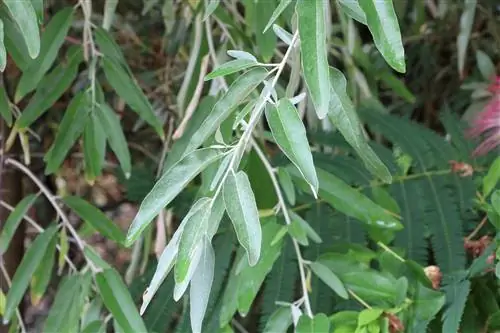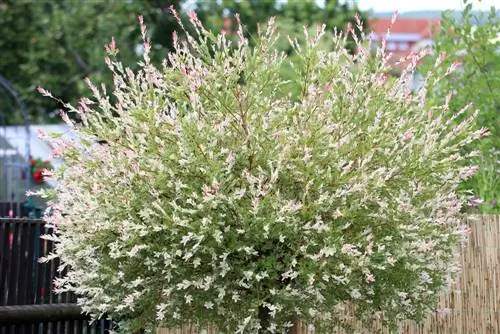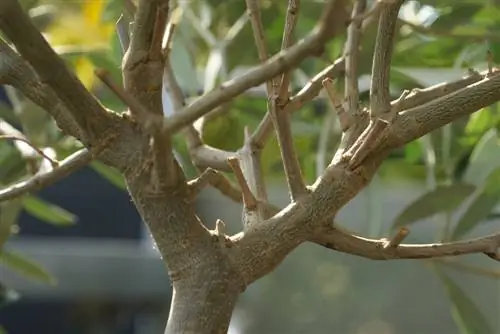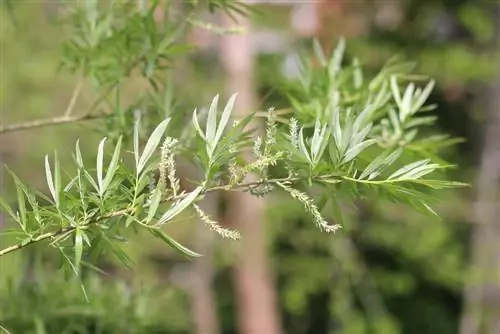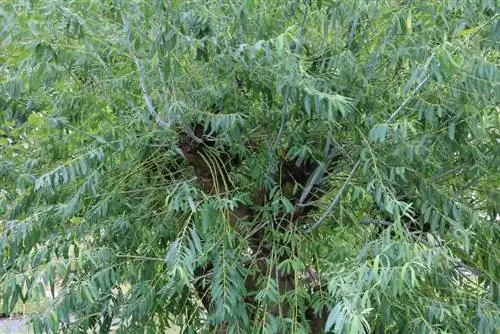- Author admin [email protected].
- Public 2023-12-17 03:39.
- Last modified 2025-01-24 12:45.
The narrow-leaved olive willow can withstand temperatures of up to -20°C, but this only applies to specimens that were planted freely in the garden and had sufficient time to prepare for winter. Frost damage can also occur with these, but Elaeagnus angustifolia recovers quickly. However, for head cuttings taken in summer and in containers, overwintering indoors is necessary. Here they should be kept in a bright place at temperatures of 5 °C to 10 °C. The soil must not dry out completely, but watering should be done sparingly and only when necessary.
Diseases, care errors and pests
Diseases and pests occur extremely rarely on the robust olive willow. If parasites do appear, such as aphids, the affected parts of the plant can simply be cut off and destroyed. Introducing beneficial insects, such as ladybirds, also helps prevent excessive feeding damage. In terms of diseases, rot is the most common, but this usually results from errors in care. Soil that is too moist, caused by excessive watering, high groundwater or a lack of drainage, quickly leads to root rot in Elaeagnus angustifolia. The first sign of this is early loss of leaves and the plant suddenly becomes bare. If the waterlogging was not caused by excessive watering, you should change the conditions at the location. Adding a drainage layer, sand or coconut fiber loosens the substrate and keeps it drier. With these measures, an olive willow can in some cases be saved even if it is already suffering from rot.
Frequently asked questions
Why does the olive willow lose leaves?
If Elaeagnus angustifolia becomes bare, the reason for this is usually that the soil is too wet. Adapted watering, drainage or loosening of the soil can help.
Is the narrow-leaved olive willow poisonous?
The olive willow is not poisonous and is therefore suitable for planting in gardens where pets and children play.
What you should know about olive pasture in brief
Care and plants
- The olive willow likes a sunny to partially shaded location. It should be a little moist.
- The garden varieties are ideal for all locations. They prefer sandy soils, but can also cope with loamy ones.
- The bushes often grow a bit bulky, but they also cope well with pruning.
- If the olive willow is not in full sun, it grows crooked, always towards the sun.
- Olive willow must be watered well during the growing season. Then you fertilize every 14 days.
- Planted specimens can be fertilized with mature compost. Spread the compost in a thin layer in the root area in spring.
- Caution when watering: If there is too little liquid, only the upper centimeters of soil will be wetted, but the lower roots will die in the medium term.
Wintering
- Overwintering takes place in a light area. If the location is too dark, the leaves fall off. It takes a long time for the plant to sprout again.
- The temperatures should be around 5 ºC. Since the olive pasture is evergreen in autumn, the soil must be slightly moist even in winter.
- When kept outdoors, it is recommended to place the planter elevated on feet or polystyrene plates.
- In severe winters, additional winter protection is advisable. The olive willow can tolerate temperatures down to -15 ºC for a short period of time.
Cut
- Young plants are pruned several times so that they branch better. Older oil willow plants can grow freely.
- Every now and then you cut out older branches close to the ground. Plants that have become too large can easily be shortened.
- The best time for this is March.
- If you don't cut back the olive willow, it will become strong and sprawling.
- The plant branches better and becomes bushier if you cut it regularly.
- The main pruning takes place at the end of winter, shortly before new growth.
Pests
- Pests usually appear as a result of stress. This especially happens during long periods of drought.
- Otherwise, the olive willow is a robust plant with a he althy immune system. Pests usually don't bother her much.

